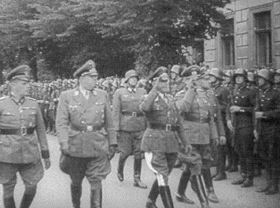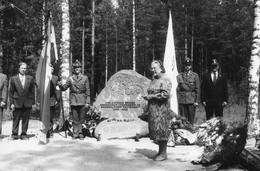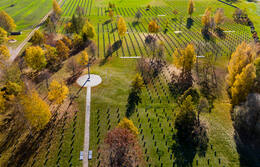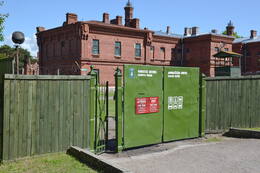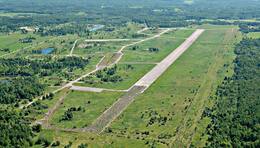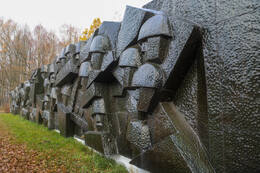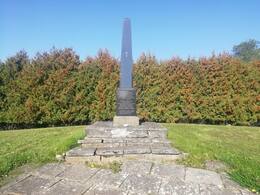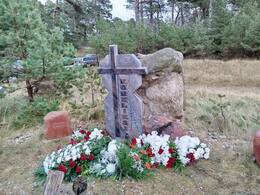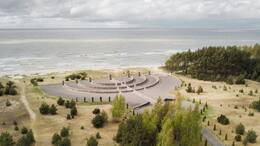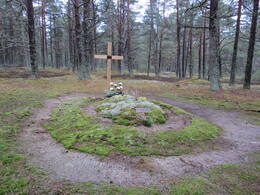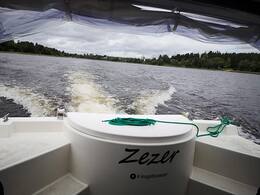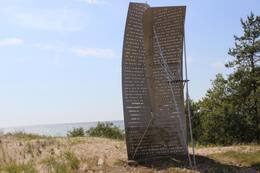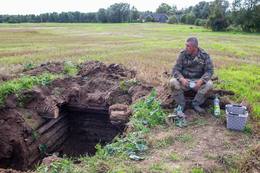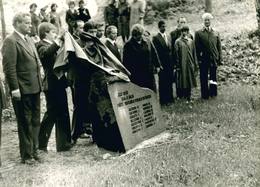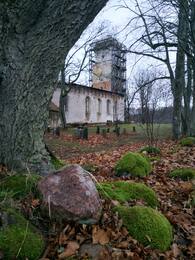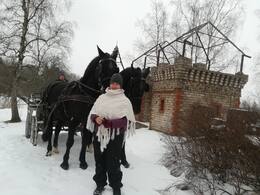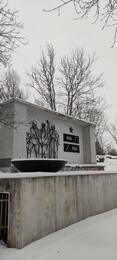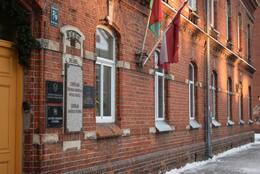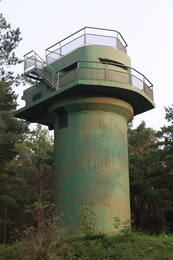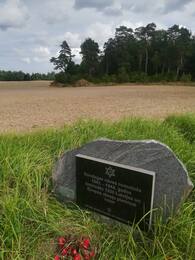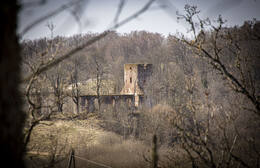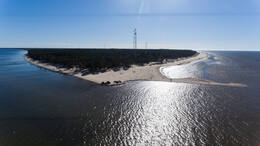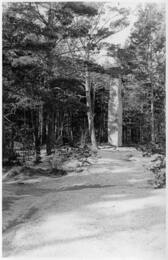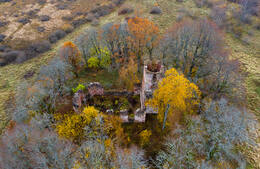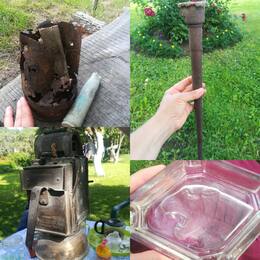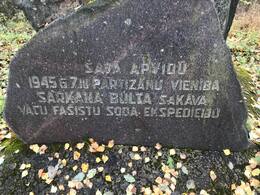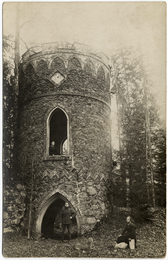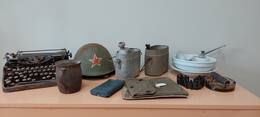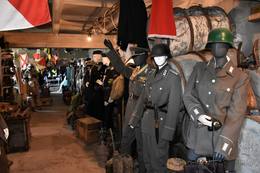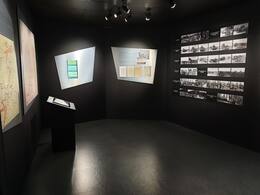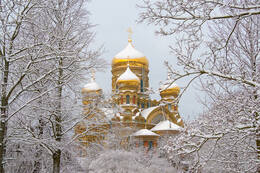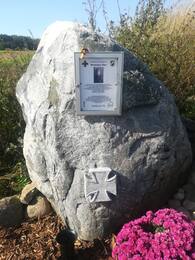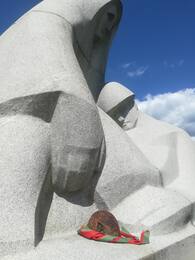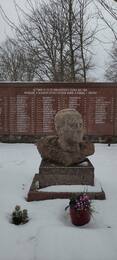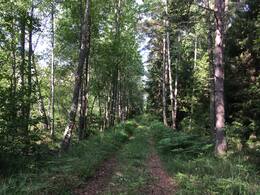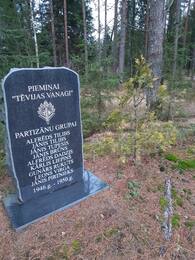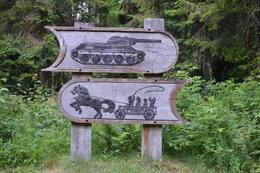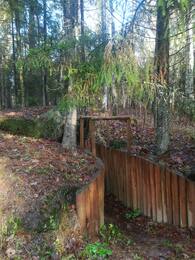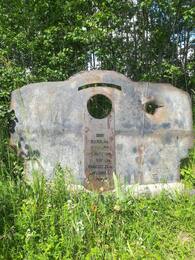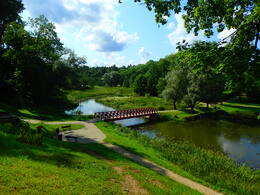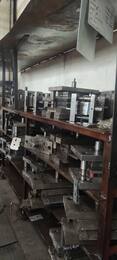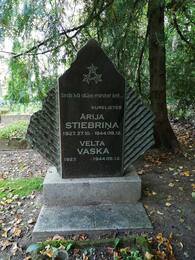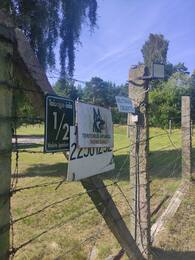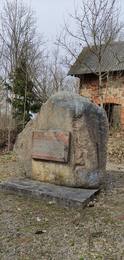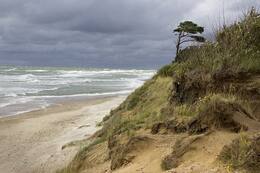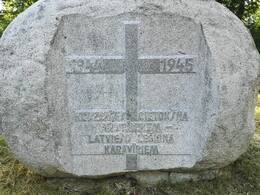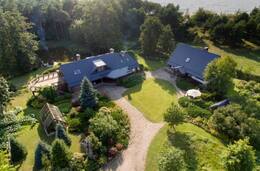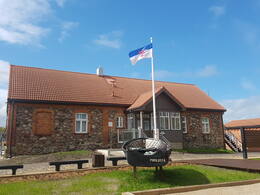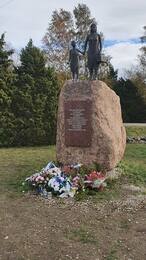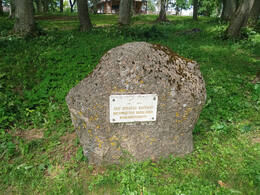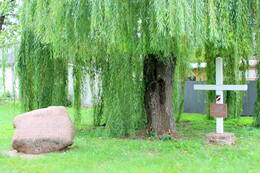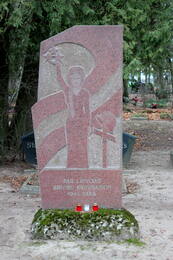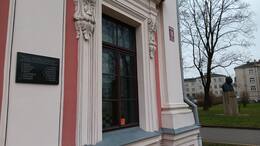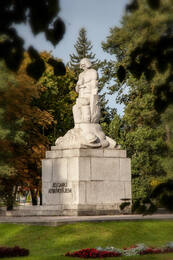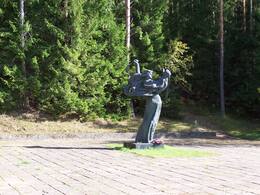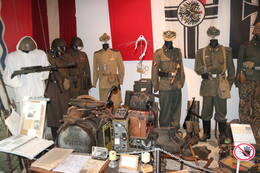German/Nazi occupation II WW2
The period from 22 June 1941 to 9 May 1945 when the territory of Latvia was occupied by German forces. On 22 June 1941, Nazi German troops attacked the USSR without declaring war.
German occupation authorities initiated monetary reform and ordered the physical destruction of certain groups of the population. A German Civil Administration was established and, on 1 September 1941, it took the entire territory of Latvia under its control.
Two Reich Commissariats were established, Reichskommissariat Ukraine and Reichskommissariat Ostland. The latter was headquartered in Riga with four Commissariats-General under it, one for Estonia, Latvia, Lithuania and Belarus. The Head of the Commissariat-General for Latvia was Otto-Heinrich Drechsler.
Due to a lack of officials, the German Military Administration (Militärverwaltung) allowed the establishment of local government entities whose primary task was to provide German warring units with supplies and to establish order.
Related timeline
Related objects
Memorial to the fallen soldiers of the Latvian Legion and national partisans
Located in Indrāni Parish, Lubāna New Cemetery.
A memorial place to the fallen soldiers of the Latvian Legion and national partisans can be seen
The memorial was opened on July 25, 1992. The memorial stone was created by Andris Briezis.
At the beginning of the Awakening, in October 1990, Kārlis Doropoļskis, a member of the Helsinki 86 human rights group, received permission from the authorities to resume the joint burial of Latvian legionnaires the cemetery of the brothers, which was arranged in the new cemetery of Lubāna. A total of 26 fallen legionnaires and national partisans were buried in the brothers' cemetery.
Saldus German Soldiers' Cemetery
Saldus German soldier's cemetery is located on the Saldus-Ezere highway. Around 25,000 German soldiers, as well as some Latvian legionnaires, were reburied in the 8-hectare cemetery. Reburial has been taking place since 1997.
From May 1 to October 1, an exposition on the Battle of Kurzeme can be seen in the memorial room. During this period, the memorial room is open on weekdays from 9:00 a.m. to 5:00 p.m., on Saturdays and Sundays the cemetery also has a tour guide. The registers of soldiers buried in Saldus German soldiers' graves and fallen soldiers throughout Latvia are also available.
Vaiņode air base
Vaiņode airfield still has 16 Soviet-era aircraft hangars and an 1800 m section of the once 2500 m long runway. The airfield can only be visited with a previous booking. Vaiņode airfield was established during the Latvian independence as one of the cradles of Latvian aviation and was later one of the largest military airfields in the Baltic States. In 1916, two hangars for German Army airships were built. Airships were used to gather intelligence and bomb the positions of the Russian Army. Later the city of Riga bought the airship hangars and used their roof structures to build the pavilions of the Riga Central Market. In May 1940, the 31st Fast Bomber Aviation Regiment of the Red Army moved to Vaiņode, and the construction of a standardized concrete slab runway began. At the end of the summer of 1944 the partially completed airfield was used by various German aviation units, however, at the end of World War II, the same airfield was used by the Red Army aviation units fighting the German Army group called ‘Kurzeme’. After World War II the Soviet Air Forces were stationed in Vaiņode until 1992.
Priekule Memorial Ensemble of Warrior’s Cemetery
The Priekule Memorial Ensemble of Warrior’s Cemetery is on the Liepāja-Priekule-Skoda road and is the largest burial site of Soviet soldiers of World War II in the Baltics. More than 23,000 Soviet soldiers are buried here. Operation Priekule was one of the fiercest battles in Kurzeme Fortress that took place from October 1944 to 21 February 1945. The Battle of Priekule in February 1945 lasted seven days and nights without interruption and had a lot of casualties on both sides. Until Priekule Warrior’s Cemetery was transformed into a memorial, the last monument of the outstanding Latvian sculptor K. Zāle (1888-1942) was located here to commemorate the independence battles in Aloja. Between 1974 and 1984, the 8 ha Priekule Warrior’s Cemetery was transformed into a memorial ensemble dedicated to those who fell in World War II. It was designed by the sculptor P. Zaļkalne, architects A. Zoldners and E. Salguss, and the dendrologist A. Lasis.
The centre of the memorial holds a 12 m tall statue called the ‘Motherland’, and names of the fallen are engraved on granite slabs. Until Latvia regained its independence, the Victory Day was widely celebrated every year on May 9.
Zlēku Tragedy Memorial Site
The memorial is located near the Zlēki Manor ensemble, in the western part of Karātavkalns. Around twenty boulders with the names of the people killed form a circle, and in the centre is a black marble obelisk about three metres high.
Some of those killed have been reburied at the Zlēki memorial.
In December 1944, in the vicinity of Zlēki, the German Nazi army carried out a large-scale operation against the civilian population.In the combat action log of Army Group Nord, an entry was made at 17.30 on 9 December 1944 that 161 people belonging to the "Rubens Brigade and units of the Red Arrow" had been killed on the enemy side during the action. In Soviet times, this figure was apparently taken as the total number of victims of the Zlēki tragedy, referring to civilians killed.
The course of the action is partly documented in the report of the head of the counter-intelligence section of the German 16th Army of 31 December 1944. It explains that from 5 to 9 December, under the leadership of the highest SS and police leader in Ostland, SS Oberruppenführer and Police General Friedrich Jekeln, a large-scale operation took place at Eichensumpf ("Oak Swamp") against the "Red Arrows" and the remnants of General Kurel's group at Abava.
Mērsrags lighthouse and former border guard
Mērsrags Lighthouse is located in the Mērsrags village, about 1 km north of the village centre. The lighthouse was put into commission in 1875. It is an 18.5 m tall freestanding, cylindrical, riveted iron tower, the lower part of which has been fortified with reinforced concrete counterforts. The height of the signal light is 21.3 m. At the top all around the tower there is an iron balcony supported by consoles. The lighthouse tower was made by Sotera, Lemonier & Co in Paris, so this lighthouse is commonly known as the ‘Frenchie’. At the end of 1944, the 1003rd Artillery Division Battery of the German Army with 60 cm spotlights was located right next to the lighthouse. In May 1945, the Nazi Germany high command planned to move the 15th Latvian SS Grenadier Division to the area, but these plans failed, because Latvian soldiers surrendered to the Western Allies. Near the Mērsrags Lighthouse there are still remains of a building where during the USSR times Soviet border guards had a large, extendable spotlight for illuminating the sea. There is a bird-watching tower next to the lighthouse. Tours need to be booked beforehand by contacting the Mērsrags Tourism Information Centre.
The place where General Kurelis's staff officers were shot
At the end of July 1944, when the Red Army invaded the territory of Latvia, the German occupation authorities allowed Jānis Veide, the Riga District Police Chief and Commander of the 5th Riga Guards Regiment of the restored Latvian Guards Organisation, to establish the "General Kurelis Group of the Riga Guards Regiment". The head of the Military Commission of the Central Council of Latvia, General Jānis Kurelis of the Latvian Army, became its leader.
The Kurelis operated in Vidzeme until September 1944, when they moved to Kurzeme, where they were stationed in the houses of Stiklis in Puzes parish, Ilziķi in Usma parish, Iliņi in Ģibuli parish, and in Edole and other places in Northern Kurzeme. By the end of October 1944, the Kurelies had about 3,000 armed men, among them many former soldiers of the Latvian SS Volunteer Legion units, who joined the unit to realise their dream - the fight for Latvia's independence.
At the beginning of November 1944, the German occupation authorities' Supreme Police and SS leader in Ostland, SS Oberruppenführer Friedrich Jeckeln, began to restrict the group's activities and on 14 November arrested the Kurelian headquarters and more than 700 soldiers in Stikliai, Puse parish. The battalion commanded by Lieutenant Robert Rubens, with about 500 men in the Usma area, resisted and continued fighting until December 1944.
On the night of 19/20/1944, the Germans fought against the Germans. On November 19-19, 1944, a court-martial of the German occupation authorities was held in Liepāja Karaostas Prison, sentencing to death eight staff officers of General Kurelis' group - Colonel Pēteris Liepiņš, Captain Kristaps Upelnieks, Captain Jūlijs Mucenieks, Lieutenant Jānis Gregoras, Lieutenant Teodorma Prikulis, Lieutenant Jānis Rasas, Lieutenant Filipson and Adjutant Kārlis Valters. Three staff officers, Lieutenant Colonel Eduards Graudins, Lieutenant Arthurs Ankravs and Sergeant Vili Pavulāns, were pardoned for various reasons. On the afternoon of 20 November, the convicts were shot in the dunes near the Karosta prison, where a white cross can be seen today.
In 1994, a memorial to the officers who were shot was established in the dunes of the Liepaja Karosta. In 2012, after it was washed into the sea, the memorial was restored to its present location.
*** Translated with www.DeepL.com/Translator (free version) ***
Memorial to the victims of holocaust in Liepāja
The largest memorial to Holocaust victims in Latvia is located in Liepāja, in the Šķēde dunes. The memorial is dedicated to the memory of more than 3,000 Liepāja Jews killed during World War II. It is in the form of the Israeli national symbol, a seven-branched candelabra known as the menorah. The contours of the memorial, which are clearly visible from a bird’s eye view, are made of split boulders and granite blocks. The ‘lights’ of the menorah are made of granite pillars with inscriptions of verses from the Lamentations of Jeremiah in Hebrew, English, Latvian and Russian.
Lithuanian soldiers' graves in Zaļkalns Forest
The memorial is located near the Pāvilosta beach lookout tower in the dunes. There are signs pointing to the memorial.
At the end of the Second World War, three Lithuanian police battalions, the 5th, 13th and 256th, were also deployed in Latvia, and after guard duty and fighting against Soviet partisans and the Red Army on the Eastern Front, from autumn 1944 they were involved in guarding the Baltic Sea coast in Kurzeme.
In October 1944, all three battalions, consisting of 32 officers and about 900 instructors and soldiers, were subordinated to the German 18th Army's 583rd Rear Guard Unit (Koruck 583). The unit was tasked with guarding the Kurzeme coast from Liepāja to Ventspils. All three Lithuanian battalions were deployed in the vicinity of Pavilosta. In December 1944, the 13th Battalion was transferred to the German 1st Army Corps at the Liepaja Lake.
One of the tasks of the Lithuanian coastguard, besides being ready to fight enemy landings and to report enemy ships, was to prevent Latvian refugee boats from sailing to the island of Gotland, 160 kilometres away, but the Lithuanian coastguard men did not prevent the refugee boats from leaving. However, news of the Lithuanian coastguard helping the Latvian refugees and the Lithuanians themselves preparing to cross the sea to Sweden also reached the Germans.
On 10 January 1945, the soldiers of the 1st Company of the 5th Lithuanian Police Battalion were rounded up. More than a week of interrogation and trial followed, which, as a warning to the others, decided to execute seven of the Lithuanian soldiers and to imprison 11 of their comrades in concentration camps in Germany. The execution of the seven Lithuanian soldiers (Sergeant Macijauski, the company commander; Juozas Sendrjuas, a soldier; Vladas Salickas, a soldier; Ionas Bašinskis, Krasauskas and two unknown others) took place on 21 January 1945 in the Zaļkalns Pines in Pavilosta.
In January 1945, the 5th Battalion was disbanded and the combat-ready soldiers were divided into the two remaining battalions, while the rest were formed into a separate sapper company. At the time of the surrender of Army Group Kurzeme in May 1945, two battalions (13th and 256th) were still in Kurzeme as a sapper company with a total of 900 soldiers who were taken prisoner by the Soviets.
Boat trip in Ciecere lake by the boat “Zezer”
During the ride with the recreational boat “Zezer” along Lake Ciecere near Brocēni you can listen to the audio guide and captain's stories about Lake Ciecere and the city of Brocēni on its shores, World War II events near Lake Ciecere, trenches on both sides of the lake and the Oak Island, as well as the tank route running along an observation tower and the tank that is said to be sunk in the lake. The audio guide is available in Latvian, Lithuanian, English, and Russian languages. The ride takes 1 hour 15 min.
Memorial sign for refugees "Sail of Hope" in Jūrkalne
The "Sail of Hope" commemorative sign for the World War II refugees who crossed the Baltic Sea by boat to the island of Gotland in Sweden in 1944 and 1945. The memorial is located in Osvalki on the dunes between the sea and Ventspils-Liepaja highway, near the public transport stop "Kaijas". It was created by sculptor Ģirts Burvis, who realised it as a sail of hope symbolising the memory of Latvian refugees.
Between autumn 1944 and spring 1945, fearing the renewed Soviet occupation but unwilling to evacuate to a devastated and threatened Germany, some Latvian citizens tried to reach the nearest neutral country, Sweden, by sea. Some of the boats were organised by the Latvian Central Council with the help of the Western Allied countries, which resulted in one of the largest refugee concentration points in Jūrkalnes parish. Besides the boats organised by the Latvian Central Council, other boats were also taken across the sea. It is estimated that about 5000 persons managed to cross the sea. The number of deaths is unknown, as no records were kept of refugees leaving the Kurzeme coast.
The voyages were dangerous because the refugees were threatened by German patrols on the coast and at sea, sea mines, Soviet aircraft and warships, as well as storms, as the crossings often took place in unsuitable and overloaded cutters and boats without sufficient fuel and food supplies, sea charts and navigational instruments. Departures from Latvia were carried out in secret. The destination of the boats was the island of Gotland, and the journeys most often started on the west coast of Courland (from Jūrkalne to Gotland is 90 nautical miles or about 170 kilometres as the crow flies).
WWII German army bunker
It was located near the house in "Brankša" on a grain field.
On September 2, 2021, under the guidance of Andras Grabčiks, a history enthusiast of the Saulkrasti region, and in coordination with Ines Karlova, the tenant of agricultural land, excavation works of the German army bunker of the Sigulda defense line of World War II took place.
"77 years have passed since the bunker was built, experienced both the attack of the Soviet Army and the driving of agricultural machinery over it. Only 3 years ago, it partially succumbed to the heavy machinery. To prevent the floor from being flooded, a drainage system was developed with a water storage reservoir at the entrance, which, if necessary, exhausted. The floor of the bunker is made of round logs 10 cm in diameter and was covered with straw. This bunker is not one of the big ones, but quite enough for about 6 people. This bunker is not the only one in the area, but one of the few that is well preserved." - this is what Andris Grabčiks says about the bunker.
After the information was published on the Internet, 2 scanned historical photographs were received from the historian and owner of the Saulkrasti Bicycle Museum, Jānis Seregins, with the inscription "29.08.44, Saulkrasti, Vidrižu parish" and the comment: "The photographs were obtained from a Saulkrasti resident, who is now dead. According to her story, refugees from Pskov and Leningrad region, who were driven out of their homes by the retreating Germans, had settled in Saulkrasti. They were employed in digging trenches in the defense line near Ķīšupe. One of the pictures shows people in forest works. In this way, the logs that we can see now in the bunker near Brankša were obtained. The second picture shows how they are fed at a distribution point near the house or in the kitchen. I think it's the Branch Mill."
The bunker has been preserved from WWII on the defensive line of Sigulda.
The site of the first rezi bunker was surveyed in April 2021, but due to the high ground water, excavation work could not take place.
The bunker is located on agricultural land and after excavation and exploration, it was filled in so as not to interfere with agricultural work.
Monument to Soviet activists killed in 1941
It is located in the territory of the castle ruins of Rauna, opposite the stage.
The monument to Soviet activists killed in 1941 and the ruins of Rauna castle can be viewed.
When Nazi German troops occupied the territory of Latvia and entered Rauna, on July 8, 1941, 14 Soviet activists were shot in the castle ruins of Rauna.
Among them were trade union activist Roberts Ogriņš and his son, student Ādolfs Ogriņš, pioneer leader Jānis Lakats, agricultural workers Kārlis Palsis, Jānis Zariņš and Anton Noviks, member of the Rauna parish executive committee Jūlijs Gailītis, farmer Jānis Geižins, tractor driver A. Alders, blacksmith Jānis Kaštanis, militiamen auxiliary service members Jūlijs Ceriņš and Artūrs Milnis and worker Ēvalds Plētiens. In the official articles, this event is treated as a showdown with the supporters of the Soviet government, however, in the memories of local residents, this event is treated more as a personal showdown of one Raunenian with other Raunenians.
After the killing, the victims were buried right there at the foot of the castle ruins, but later they were reburied in the cemetery. After the end of the Second World War, a temporary monument was installed at the shooting site, which was later replaced. The monument currently in the castle ruins was erected in 1982.
Red Army prisoner filtration camp in Grieze and Grieze Church
Grieze is located at the Latvian-Lithuanian border, where the Vadakste River flows into the Venta River. The Grieze church was built in 1580, but the parish existed before 1567. The church was rebuilt several times - in 1769, in 1845 and in 1773 the first organ was installed. Both the altarpiece and the two bells have been lost for various reasons.
In the church garden there is a cemetery where people belonging to the church and noblemen are buried. One of them is Grieze organist Friedrich Baris and his wife Charlotte, who have a monument erected in front of the church sacristy. On the south side of the church, 32 Swedish soldiers who died in the Great Northern War are buried. The cemetery also contains the graves of 110 German soldiers who died in the First World War, for whom a monument was erected in 1930.
During the Second World War, the church suffered when the front line was stretched along the Venta River in late October 1944 and the German 225th Infantry Division was stationed in the vicinity of Grieze Church. When the Soviet 4th Shock Army launched attacks across the Venta River on 19 November 1944, several artillery shells hit the south wall of the church and the church tower was badly damaged.
After the surrender of Army Group Kurzeme, the Red Army's Leningrad Front accounted for 284 171 people taken prisoner. 7493 were Red Army soldiers released from German captivity. 48 German generals surrendered to captivity. According to the documents submitted at the time of the surrender of Army Group Kurzeme, the number of soldiers was about 185 000. The rest of the nearly 100 000 people subjected to filtration were Kurzeme civilians and Soviet refugees, as the Soviet Leningrad Front ordered on 10 May 1945 that all men between the ages of 16 and 60 be subjected to filtration.
In the Red Army, unlike the armed forces of other countries, the screening, guarding, maintenance and protection of prisoners of war was carried out not by army units, but by the internal affairs bodies - the People's Commissariat for State Security. The main task of the filtration was to detect citizens of the USSR and Soviet-occupied countries who had taken part in the hostilities on the German side. Captured German soldiers were examined in order to detect possible perpetrators of war crimes.
A prisoner-of-war filtration camp was located in the vicinity of the Grieze Church from 10 May to 17 June 1945. The camp was probably located here because the Grieze Church was close to the main roads. The pits in the ground where the prisoners hid from the cold on cold nights by covering themselves with whatever was available are still clearly visible in the surrounding area. During this period, the Red Army caused considerable damage to the interior of the church (all the pews were removed - "for the war effort", the pulpit was damaged, the organ was destroyed, etc.). A laundry was set up in the church building itself.
The last service in the church was in 1950 and the congregation ceased to exist. After the dissolution of the congregation, also later under the supervision of the Latvian Society for the Protection of Nature and Monuments, the church was not repaired. However, the building stood under roof until the 1960s-1970s. The church was damaged during the storm of 1961 and in 1968 the remaining interior elements were rescued by the Rundāle Palace staff.
Since 2003, a group of like-minded people from Riga parishes have been involved in the clean-up and restoration of the church. To date, the church walls have been conserved and the tower has been restored.
Horseback riding and horse riding tours around Paplaka and Priekule
The thematic horse-drawn carriage tours offered by the owner of the Stiebriņi farm, such as a horse-drawn carriage ride on a railway embankment, listening to a guide talk about the industrial heritage, are a great adventure. A horse-drawn carriage ride through the sites of the former military garrisons/towns around Paplaka will also be unforgettable. We particularly recommend the children's playground of the Soviet army housing estate, known locally as "Disneyland", the Finnish cottages (a Finnish wartime contribution to the Soviet Union), the water towers and the ruins of the former luxurious buildings of Barons fon Korfs.
Liepaja Fortress Middle Fort and Monument to the Soldiers of the Red Army
The most dangerous direction of attack for the port of Emperor Alexander III was from the east between the lakes of Tosmare and Liepāja, where there was a 2.5 km wide strait of land. Three fortifications were built to defend the land strip. On the southern shore of Lake Tosmare there was a left redoubt, on the northern shore of Lake Liepāja a right redoubt, and between the redoubts there was a Middle Fort. The Middle Fort was the most serious fortification of the Liepaja Fortress, but it was not fully completed and artillery was not deployed until 1908.
It was at the Middle Fort that the most serious battles took place in April 1915, when German troops attacked, in November 1919 during the Latvian Army's battles against the West Russian Liberation Army, and in June 1941, when Liepāja was attacked by the 291st Infantry Division of the German Armored Forces.
In June 1941, when hostilities between Nazi Germany and the Soviet Union broke out, the Liepaja garrison of the Soviet Army consisted of units of the Liepaja naval base of the Navy and the Red Army. The Liepaja naval base consisted of mine trawler, torpedo boat and submarine divisions, including former Latvian Navy ships and submarines. The coastal defence was carried out by the 23rd and 27th artillery batteries with 130 mm guns and the 18th railway artillery battery with 180 mm guns, covered by two Zenith artillery divisions. The base also included several sapper, repair, liaison and training units, totalling some 4 000 soldiers, commanded by Captain M. Klevenski, 1st rank. Of the Red Army units, the garrison was manned by the 67th Rifle Division (minus the 114th Rifle Regiment and one artillery division), commanded by Major-General N. Dedaev. The division had about 9000 soldiers before the outbreak of hostilities. The 143rd Fighter Aviation Regiment with 68 aircraft of various types was stationed at Liepāja airfield. In addition, the 12th Border Guard Unit operated in the Liepāja area.
The battle action at the Liepaja Fortress began in the early morning of 24 June 1941. Despite the Soviet losses, the German units were unable to break through the Liepaja Fortress rampart on 25 June. The fighting in Liepāja ended on 27 and 28 June, when Soviet units tried to break northwards.
Liepaja Museum exhibition "Liepaja under the occupation regimes"
The Liepāja Museum exhibition "Liepāja under the occupation regimes" is located in Liepāja, 7/9 Klāva Ukstiņa Street.
The exhibition covers the period from 1939 to 1991 during the double Soviet and German occupation. The inhabitants of Liepāja were among the first in Latvia to experience the outbreak of the Second World War and among the last for whom the war ended both literally and symbolically.
It was not until the collapse of the USSR in the late 1980s that the opportunity arose to restore Latvia's independence. The Latvian People's Front played a major role in this process, and its exhibition, opened on 21 January 2001, is housed in the former headquarters of the Liepāja City Branch. The Liepāja branch of the Popular Front was the second largest after the Riga branch, with 13 000 members. It was from here that buses of volunteers were organised during the barricades in January 1991 to go and defend the sites in Riga. On 23 August 1991, the day of the Molotov-Ribbentrop Pact, the Lenin Monument, a symbol of Soviet power in the city, was dismantled. In later years, 500 bronze bells were made from it in Germany - souvenirs of a bygone era. One of these bells is also on display.
World War II and the Soviet occupation of Liepāja ended only in 1994, when the last troops of the USSR's heir, Russia, left the city.
The museum regularly organises thematic exhibitions of its collection and artworks, as well as lectures and meetings with historians and eyewitnesses of recent Latvian history. The museum building is currently being renovated and the exhibition is being renewed.
Fire correction tower of the Ventspils 46th Coastal Defence Battery
The restored fire control tower of the 46th Coast Guard Battery in Ventspils is located on Saulrieta street and is available to visitors in the form of an observation tower. There are four artillery gun positions near the tower and it is the only World War II coastal defence battery in Latvia in such a good condition. Visitors can take the tower stairs to an outdoor viewing platform overlooking the sea. An information stand with a QR code is available next to the tower. You can use the QR to watch an animation about historical events. There is a new street leading to the tower, a large parking lot and a wooden footbridge that crosses the protected nature area next to the tower.
This military complex was built in 1939, marking the start of construction of USSR military bases in Latvia. The 46th Coast Guard Battery had four positions for the gun type Б-13. This battery had its first military engagement on 24 June 1941, when Ventspils harbour was attacked by German torpedo boats that were driven away from the shores of the Baltic Sea by battery fire. On June 28 the Soviet Army blew up the guns and left.
German army coastguard searchlight site in Usi and border guard post in Kolka
No military infrastructure was planned in Cape Kolka, except for several offshore lighthouses that were rebuilt over a long period of time, either before World War I, during World War I or during World War II. Coastal defence batteries were planned for the narrowest part of the Irbe Strait, between the Sirves Peninsula and the Michael Tower Lighthouse.
The only fortifications of a military nature appeared at the end of 1944, when the German Army Group North was preparing to repel possible landings by the Soviet Baltic Fleet. In the spring of 1945, after the ice retreated, two batteries of the 532nd Artillery Division defended the coast at Cape Kolka. Battery 7 with four 75 mm guns and three 20 mm zenith guns. Battery 8 with four 88 mm mortars, three 20 mm mortars and an 81 mm mortar. The anti-deserter infantry garrison consisted of one of the most famous coastal defence units of the German Navy, the 5th Company of the 531st Artillery Division. Although it was an artillery unit by name, it was an infantry unit by deployment, which started its war in June 1941 at Liepāja. The unit was then garrisoned on islands in the Gulf of Finland and later took part in the fighting on the island of Saaremaa. The remnants of the division were reformed into one company and, reinforced with seven anti-tank guns and three 20 mm anti-aircraft guns, deployed at Cape Kolka.
The Soviet naval landing operation never took place and the German units capitulated in May 1945.
The military infrastructure in Cape Kolka began to be built after the Second World War, when Soviet border guard posts were deployed here and Kolka, like the entire Kurzeme coast from Mērsrags to the Lithuanian border, became a closed zone
German Army concrete tower (by the beach)
Walking along the slope of Mount Odju for 200 m along the path, you can see several objects related to the First World War - old concrete foundations of cannons from. An unfinished concrete observation tower stands next to the beach, parallel to the forest path along the Rojas Trail. The exact use of this object is unknown. Below the base, niches have been built for ammunition. Deep pits, former dugouts, are also visible among the pines.
Some of the objects probably date back to the end of the Second World War, when German coastal defence batteries were stationed in the area. The 4th Battery, 532nd Artillery Division, Navy, was armed with four 88 mm guns, three 37 mm guns, one 20 mm four-barrelled gun and one 50 mm mortar for illumination at night. Two 45 mm anti-tank guns are deployed at the mouth of the Rojas. The town garrison consisted of units of the 64th and 109th Sapper Battalions.
Ruins of Ķērkliņu church
The ruins of the Ķerkliņu Church are located about 5 kilometres north-west of Kokmuiža, near the Ķerkliņu Lake. The church was built in 1641 by Heinrich von Dönhoff (Derkarth), the owner of the Ķerkliņi manor. The original wooden church was replaced by a stone building, under which tombs were built for the dead of the Dönhof and later Kleist families. The tombs were already destroyed during the 1905 riots, but in 1949 the coffins were moved from the tombs to the church. The church was an example of the Kurzeme Baroque style - its carvings were made by the Kuldīga - Liepāja woodcarvers. Although the owners of the manor and the church were at various times plagued by financial problems, the church underwent several reconstructions during its existence. It also suffered during the First World War, after which the parish rebuilt the stonework in 1929 and added an organ in 1934. Unfortunately, the church was damaged during the Second World War and much of it was lost, so it is to be commended that before the church was rebuilt in 1933, many unique pieces of Baroque sculpture were photographed, inventoried and even ended up in the archives of the Monuments Board. With the establishment of the landfill and the eviction of the inhabitants, the church was never restored. Today, the church walls and tower are visible.
Memorial stone of the Soviet partisan unit "Red Arrow"
The Soviet partisan unit was formed on 30 September 1944, when 19 soldiers of the German 283rd Police Battalion, under the leadership of Vladimir Semyonov, deserted with their weapons. The battalion was formed in 1943 from volunteers from the Latgale region and took part in the anti-partisan operations of the German occupation authorities in the territory of Latvia and Belarus.
The unit was called "Semyonov Unit" after its commander and only at the end of the war adopted the name of "Red Arrows", which was already spread by Soviet propaganda after WWII. By December 1944, the unit had 300-400 partisans. Most of them were escaped Red Army soldiers, former Legionnaires, including fighters left after the destruction of General Kurel's group. Although many Red Army reconnaissance groups were active in Kurzeme at this time, they avoided close cooperation because the activities of the commander of the partisan unit and its main core in the ranks of the German police were too suspicious. The Red Arrow's activities were relatively poorly organised and more focused on waiting for the end of the war. During its activities it carried out extensive terrorising of the local population.
Vladimir Semyonov, the first commander of the Red Arrow, drowned on the night of 10 December 1944 while knee deep tried to cross the swollen Abava River. His corpse was found only in the spring of 1945 and buried. He was reburied in Kuldīga in 1961.
The monument is located on the site of the "Red Arrow" and other guerrilla camps in the area (about 50-70 people), which on 7 March 1945 was surrounded and attempted to be destroyed by German troops.
Remte manor house and park
Remte Manor Castle (German: Remten) is a manor house located in Remte. The buildings and the park of Remte Manor are national monuments. The manor house houses the Remte Primary School. Remte Manor Palace was built in 1800 in the Berlin Classicist style for the then owner of the manor, Count Karl Medem.
At the end of World War II, the 19th Division of the Latvian Legion of the German Army Group was stationed in Remte Manor and its surroundings.
Virga manor antiquities storage
A storage room for antiques has been arranged in the house of the lords of the Virga manor. Here you can get an idea of who lived on the banks of the Vārtajas River and in Virga, as well as the Virga estate and the Nold family of barons, as well as the times of World War II and the Soviet kolkhoz in Virga. You can only look at the objects, but you can also listen to stories about topics that are interesting to visitors.
The Virga manor survived the Battle of the Kurzeme cauldron in 1944/1945 so well that a simple walk through the territory of the former manor allows you to perceive the breath of antiquity and the presence of the former inhabitants of the manor. A moment of rest at the "Karlias Zabaks" memorial of the Swedish king Charles XII or at a specially designed resting place near the Virga Tradition House will be useful not only for relaxation, but also as a reminder that Charles XII spent the winter of 1701 right here - in Virga.
In the former granary of the manor, now in the house of cultural and domestic traditions of local residents, you can rent a sauna and rooms for celebrations, including weddings.
Private military collection in Mundigciems
Private military collection in Mundigciems. Aivars Ormanis has been collecting historical objects for many years - military uniforms, uniforms, camouflage, communication devices, household items, protective equipment from different periods and countries, dating back to the Second World War, the Soviet army and the restoration of independent Latvia.
The collection is currently not well maintained and the exhibits are housed in a former collective farm barn.
Ezere local history repository “Muitas Nams” (Customs House)
The Ezere Customs House is located in Ezere near the Saldus-Mažeikiai highway at the Latvian-Lithuanian border. The act of surrender of the German Army units ‘Kurzeme’ (Kurland) surrounded in the so-called ‘Courland Pocket’ was signed in this building on 8 May 1945. It is believed that World War II actually ended in Ezere. The customs house has an exhibit covering the events of the end of World War II and exhibits detailing the history of Ezere parish from ancient to modern days. In the morning of 7 May 1945, the commander of the Leningrad Front, Marshal L. Govorov, sent an ultimatum to the command of the army group ‘Kurzeme’ to lay down arms. The act of surrender was signed by the involved parties on May 8 and it detailed the procedure of surrender, weapons collection points, documents and information to be submitted and other practical measures.
Karosta St.Nicholas Orthodox Sea Cathedral
The St Nicholas Orthodox Sea Cathedral is the visual and spiritual dominant feature of the Karosta, in stark contrast to the high-rise prefabricated housing built next to it. The church was designed and built according to the principle of 17th century Russian Orthodox churches, with one central and four side domes.
A representative cathedral was already envisaged at the time of the design of the port complex by Emperor Alexander III, but initially the port infrastructure took priority. A temporary Orthodox church was in operation from the beginning in the area of the port hospital.
Construction of the St Nicholas Maritime Cathedral began in 1900 to a design by the architect Vasily Kasyakov, which was very similar to other sacred buildings of the Russian Empire of the time. The cathedral was consecrated on 22 August 1903 and was attended by Emperor Nicholas II of Russia and his family. Until 1915, the cathedral hosted all the ceremonial events of the Russian army and navy, including the service of the 2nd Pacific Squadron in 1904 before it sailed to the Far East, where it was destroyed in the Battle of Tsushima.
After 1915, when Liepāja was occupied by German troops, the cathedral retained its sacred status and partly its furnishings, with rare services held there.
After the Latvian army garrisoned Liepāja in the territory of the Karosta, the cathedral continued to function as an Orthodox church until 1934, when it was converted into a Lutheran church for the Liepāja garrison. The church was redecorated, including the replacement of the crosses, and the three major denominations - Lutheran, Catholic and Orthodox - were able to hold services there. One Orthodox altar was retained in the cathedral, and in the late 1930s an electric organ manufactured in VEF was installed for Lutheran services.
During the Soviet military base in 1939-1941, the cathedral lost its sacred status, and during the Second World War the building was also used by various German units.
After the Second World War, the Soviet naval base authorities established a matrons' club in the cathedral and the building was converted to its new function.
In September 1991, while the Russian Federation was still in operation, the cathedral was restored to its historic name and handed over to the Orthodox Church. The first service was held on 19 December 1991 in honour of Saint Nicholas. In September 2016, the restored cathedral bells were consecrated.
Memorial site for Hermann Faul
It is located at the crossroads of rural roads, turning off the road leading from Pienava to Džūkste.
Memorial to H. Faul, and to the nine German and Latvian soldiers who fell in the battle of 27 December 1944 (probably blown up by a direct hit from a cannon shell) and who are presumed missing since then, as no remains, documents or other evidence of their identity have been found.
Red Army Soldiers Memorial Site "Pieta" in Nīkrāce municipality
The Soviet Soldiers' Cemetery is located on the Skrunda - Embute - Priekule road, which is situated on a highland between the two rivers Dzelda in the south and Koja in the north. More than 3000 fallen are buried there.
World War II battles
The Red Army launched an offensive operation from 27 October 1944, now known as the 1st Kurland Battalion, with the aim of destroying the German army group "North", later renamed "Kurland". By 5 November, the Soviet 61st Army and parts of the 6th Guards Army and the 4th Shock Army reached the River Zeld and some units of the 5th Guards Panzer Army captured the bridgeheads on the north bank of the river. Before the next attack, the 2nd Guards Army of the 1st Baltic Front was moved into this sector to reach the Skrunda-Liepaja railway line. After the initial invasion was achieved, the attack towards Kuldīga would be continued by the 5th Guards Panzer Army.
The start of the 2nd Battle of Courland was delayed by weather conditions and only began on 19 November. The Red Army made its greatest gains in the vicinity of what is now the Cemetery of the Brothers and by the evening of 24 November the 1st and 60th Rifle Corps had captured the placdarm on the north bank of the River Koj. However, the Red Army's success ended there. The German Army Group North anticipated the direction of the Soviet attacks and concentrated appropriate forces here, including two panzer divisions.
On the evening of 26 November 1944, the Red Army attacks were halted and no further attempts were made to destroy the German forces in Courland until the end of the Second World War. In the battles that followed, the task was to prevent the German army from being evacuated from Courland.
Liepaja Fortress South Fort and monument to N. Dedaev, commander of the 67th Rifle Division of the Red Army
The South Fort of Liepaja Fortress is located in the south-western part of Liepaja, between Klaipėda Street and the beach.
A fort was planned to protect the port of Emperor Alexander III from the south, two kilometres from the southern border of the city. The fort was to be located between Liepāja Lake and the sea, west of the outlet of the Thunder River, reinforcing the reinforced concrete fortifications with a moat. Although the fortifications were almost completely finished, the armaments had not been deployed. The constructed cellars were used as storage facilities both during the First World War and during the Second World War. In the 1920s and 1930s, various factories were located in the fortification area. Unlike the Middle Fort and Ravelin, the South Fort never took part in the war, because in all the wars the invaders besieged the eastern shore of Lake Liepāja and tried to invade Liepāja between Lakes Tosmare and Liepāja.
To the north of the South Fort is Liepāja's largest cemetery, the Central Cemetery. In the southern part of the cemetery there is a Red Army cemetery where Soviet soldiers who died in the vicinity of Liepāja are reburied, including the commander of the 67th Rifle Division, Major General Nikolai Dedaev, who led the defence of Liepāja in June 1941.
Mazbānīš trail in North Kurzeme
Mazbānīti is the name given to a train in North Kurzeme that transported passengers and cargo along 600 mm wide narrow-gauge railway tracks between 1916 and 1963. It is a legacy of military history from the First World War, which once played an important role in the cultural and economic prosperity of the whole of Northern Kurzeme, but especially of the Libyan fishing villages, providing connections between settlements, providing jobs.
The nature trail leads from Mazirbe to Sīkraga along the path of the former Stende - Ventspils narrow-gauge railway, or as the locals say - the path of Mazbānīš. The construction of the railway started in 1916 and it served until 1963. The narrow-gauge railway line connected the port city of Ventspils with the coastal fishing villages of Dundas and the major railway hub of Stande, thus contributing to the region's economic and cultural boom between the First and Second World Wars.
During the times of the Soviet Union, the coast was a "Closed Zone", therefore coastal villages were economically isolated and their population decreased, the presence of newly built secret army facilities also contributed to the fact that in the sixties of the last century, railway traffic was stopped.
The trail has a small loop of 15 km and a large loop of 19 km.
The GPX map is available here:
https://www.kurzemesregions.lv/projekti/turisms/unigreen/dabas-takas/mazbanisa-dabas-taka/
"Dunci's bunker" and memorial plaque to "Tēvijas vanagi" (Patriotic Hawks)
The "Duncs Bunker" with the memorial plaque "Patriotic Hawks" is located in Otaņķu municipality, in the place where the first bunker of the partisan group of the national resistance organisation "Patriotic Hawks" was located.
In the winter of 1945/46, in the village of Ķīburi in Barta parish, three patriotic men, led by Alfred Tilib (a former legionary of the 19th SS Division), founded the national resistance movement "Tēvijas Hawks", which soon had about 200 members from different places: Liepāja, Aizpute, Nīca, Dunika, Grobiņa, Barta, Gavieze. This movement fought for the liberation of Latvia.
The size of the bunker in which the partisans were housed was 4 x 4 m and was made of thick, horizontally laid logs. It was entered from above through a trapdoor with a small pine tree growing out of it, under which was a ladder. The hatches were on two floors, each with a place for 7-8 men to sleep. Unfortunately, the bunker was found and blown up in 1947.
Today, a depression can be seen in the ground where the bunker was. The site is located in the forest and can be freely accessed by anyone at any time without prior reservation.
A picnic area with a shelter is available nearby.
The memorial plaque was unveiled on 9 September 2005. The granite stele was erected by the Latvian National Partisans' Association in cooperation with the Municipality of Nīca, the Barta Forestry and the Rudes Primary School.
The object has the status of a cultural and historical monument of the region
Otanki Antiquities Store
The Otanki local museum is located in the yard of the former Rude school.
The guide's narration about the bunker and its creators, their further fate. A model of the bunker created by the students of the former Rude school (according to the partisans' own narrative) and a spatial map of the forest area of those times with marked houses of supporters and contacts can be viewed. Bunker household exhibits collected.
Advance application by phone 26323014 or email lelde.jagmina@gmail.com.
Evidence of the 2nd World War in Aizvikai Park
Aizvīkai Manor Park is located in Aizvīki, Gramzda Parish, just a few kilometers from the Lithuanian border.
The places of bunkers and trenches from the 2nd World War are still clearly visible in Aivvikai Park. One of the types of weapons was the Katyusha rocket launch system. Several such Rocket Launching Systems were located in Aizvīki Park, even after the end of the 2nd World War, and these places (caponieri) are clearly visible in nature.
This unique forest park, shrouded in secrets and legends, was created at the end of the 19th century as the Aizvīkai Manor Park, when the baron of the manor von Korff covered the nearby hilly land with a pine and spruce forest. Later, walking paths were laid on the 40 ha area, trees of other species were also planted and a pheasant garden was established.
In addition to the picturesque forest landscapes, there are also fairy-tale and fairy-tale figures made of wood, as well as stone sculptures, which tell travelers about events from the history of Aizvīkai and mark the cultural and historical places in the park. A Green Class has also been created in the park.
In order to get to know the cultural and historical heritage of Aizvīkai Manor Park more fully, we recommend using the services of a guide.
Bunker of the Red Army and caponiers in Aizvīkai Park
Aizvīkai Manor Park is located in Aizvīki, Gramzda Parish, just a few kilometers from the Lithuanian border.
The places of bunkers and trenches from the 2nd World War are still clearly visible in Aivvikai Park. The Red Army bunker has been restored in the park.
One of the types of weapons during World War II was the "Katyusha" rocket launch system. Several such Rocket Launching Systems were located in Aizvīki Park, even now these places (caponieri) are clearly visible in nature.
In order to get to know the cultural and historical heritage of Aizvīkai Manor Park more fully, we recommend using the services of a guide.
Memorial to the artillery regiment of Major J. Ozola
A memorial sign has been installed for the division of Major Jānis Ozolas on the side of the Riga - Liepāja highway, in Džukste parish, about one kilometer from the Kurzeme backwaters of the memorial site.
During the Third Battle of Kurzeme on December 31, Ozola's III Division and Major Kristaps Insberg's II Division as the last line of defense repulsed the enemy's overwhelming attack, preventing the front from breaking. In this battle, Ozol displays personal heroism and commanding ability
Jānis Ozols (1904-1947) was an officer of the Latvian Army and the Latvian Legion, a recipient of the Army's list of honor buckle, as well as a national partisan and a victim of Soviet repression.
Misiņkalns Military Heritage Trail
Misiņkalns nature park is located in the town of Aizpute. Misiņkalns is the highest place in the city of Aizpute. Its height reaches 95.4 m. The top offers a scenic view of the city. Misiņkalns nature park was started to be built in the 20th century. at first. The area of the park is currently about 28 ha.
In the territory of the park there are several places and memorials related to the events of the 20th century - the memorial stele of the soldiers who died in the Latvian Freedom Wars - the cavaliers of the Lāčpleš Order, the place of the Holocaust memorial, the place of remembrance of the repressed and the memorial plaque of the fallen red partisans.
In the park, you can get to know the plants and plantations of various rare species, as well as enjoy the untouched nature. Currently, the park is criss-crossed by renovated walking and cycling paths, and there is a motorcycle track on the territory of the park, where Latvian motocross competitions take place.
In order to get to know the cultural and historical heritage of Misiņkalns manor park more fully, we recommend using the services of a guide.
Holocaust reburial site
Nazi troops entered Aizpute in 1941. on June 28. Already at the beginning of July, some Jews were shot in the Dzirkali forest and the city park, while the rest of the Jews of the city and the immediate surroundings were arrested and placed in two city synagogues.
After that, the mass killing of Jews took place during two actions.
Today, a monument with an inscription in Hebrew and Latvian has been installed at the reburial site: "The Jews of Aizpute and other innocent victims of the German Nazis, brutally killed in 1941, are buried here. We will remember forever."
"Kurzeme key" factory
In 1890, Gertrude Lindberga founded a cardboard factory in Aizpute.
During World War 2, German military equipment and weapon repair workshops operated in the factory premises.
After the war, the Aizpute district industrial complex was established and its production was agricultural equipment. There were also weaving, fabric dyeing, and wool yarn processing workshops. Later, a furniture production workshop was also opened.
The key and building cladding factory "Aizpute" is renamed to the metal fittings factory "Kurzeme", or MFR "Kurzeme".
MFR "Kurzeme" transforms into a joint-stock company "Kurzeme slike 1" and started producing various types of non-standard metal products and successfully produces them even today.
We recommend getting to know the production plant on a tour with a guide.
Monument to the paramedics of Ruben's battalion
Ārija Stiebriņa and Velta Vaska, paramedics of the Rubeņa battalion, were reburied in the Cirkale cemetery, who were shot by German Nazi army units on December 9, 1944, together with other residents, deserters, etc. captured in the vicinity of Zlēki.
According to the stories, it follows that the young women have joined Ruben's battalion voluntarily. Together with Ruben's battalion, they went from Suntaži to Usma. However, during the Jekelna campaign, the young women were arrested on the road, taken to the forester's house in Vēlogi for questioning and shot together with a small group of other detainees. A woman, a resident of Cirkale, knew Arya and managed to rebury the remains of both girls at the edge of the Cirkale cemetery and took care of this cemetery throughout the Soviet occupation.
Under the leadership of SS-Obergruppenführer and General of Police Friedrich Jäckeln, head of the German 16th Army's counter-intelligence division, the top SS and police chief in Ostland, a large-scale operation took place in the Eichensumpf ("Oak Swamp") from December 5 to 9, which was directed against the "Red Arrow" and General The remnants of the Kurelis group near Abava.
The progress of the action is partially documented in the report of December 31, 1944.
Liepāja coastal artillery battery No. 2
Among the many objects of Liepāja Karosta, Liepāja coastal artillery battery No. 2 is still the most mysterious place in Liepaja. In battery no. 2, the ammunition depots of the troops of the various existing powers were always installed.
Liepaja Fortress Battery No. 2 was built further from the coastline and was protected by a high rampart. The batteries were armed with 16 11-inch (280 mm) mortars of the 1877 model. After the fortress was dismantled, ammunition warehouses were set up here. Due to the danger of explosions, the territory was closed to the public and guarded for 130 years, but now there is an exposition about the activities of the 1st Kurzeme Division Headquarters in the years 1919-1940s, as well as photo evidence of the 1st Liepāja Infantry Regiment, the 2nd Ventspils Infantry Regiment and the Kurzeme Artillery. regiment.
Monument to the 8th Estonian Rifle Corps of the Red Army
The monument to the soldiers of the 8th Estonian Rifle Corps of the Red Army is located at the ruins of the Kaulači half-manor farmhouse about 100 metres south-west of the road.
On 17 March 1945, the last Red Army offensive attempt in Courland began. The task of the 7th Estonian Rifle Division of the 8th Estonian Rifle Corps was to reach the Riga-Liepaja railway line west of Blidene station and to secure the attack of the 3rd Guards Mechanised Corps in the direction of Gaiki. By the evening of 17 March, the 354th Rifle Regiment reached the railway south of Kaulači half-manor through the forest and continued its attacks north-westwards, reaching the Pikuliai houses. In the Kaulači semi-mansion and further to the north-east were the German Burg-Stellung positions, defended by individual units of the 329th Infantry Division. Throughout the day of 18 March, attacks by the 354th Rifle Regiment continued unsuccessfully.
On the evening of 18 March the 354th Rifle Regiment was relieved by the 27th Rifle Regiment. The advance unit of the 7th Mechanised Brigade of the 3rd Guards Mechanised Corps, the 1st Motorised Battalion, with one tank company, was also to be used for the attack. By the evening of 19 March, in a concentrated attack, the Soviets had captured the Kaulači half-manor, seizing a section of the German-built defensive line on the dominant high ground.
Until the end of March 1945, attacks by the 8th Estonian Rifle Corps and the 3rd Mechanised Corps in the directions of Vikstraute and Remte continued, but without success.
During the fighting, the Kaulači half-manor housed various levels of headquarters and a memorial stone was unveiled on the site in May 1975.
Staldzene steep bank, from which refugee boats to Sweden were transported in 1944
In 1944, there was an active traffic of refugee boats to the shores of Sweden from Staldzene.
Memorial Stone to Defenders of the Kurzeme Fortification
Located in Tukums region, on the side of the A9 motorway, 500 m from the turn to Lesteni in the direction of Riga.
The memorial site was established in 1991 near the Rumbu houses, in the vicinity of which there was active warfare. This is a tribute to the defenders of the "Kurzeme Fortress" who fought against the Red Army in World War II. The battles were significant because they temporarily stopped the Red Army's complete occupation of Latvia. About 300,000 Latvians emigrated, avoiding crimes against the civilian population by the Soviet regime.
At the end of World War II, a peculiar situation had developed in the territory of Latvia. There were German army forces in Kurzeme, which the Red Army tried to eliminate or prevent their involvement in the fighting in East Prussia or around Berlin. "Kurzeme Fortress" - the most common term to describe the warfare in Kurzeme from 1944 to 1945. The "battles of Kurzeme" were the battles of the German army to repel the large-scale attacks of the Red Army. The Kurzeme fortress ceased to exist shortly after the German capitulation.
Today you can see a place of remembrance and rest, which has been popular among Latvian legionnaires since the restoration of Latvia's independence.
"Bambaļi" houses - one of the main places of accommodation for boat refugees
The restored "Bambaļi" houses in Ošvalki, Jūrkalne parish, were one of the main places of settlement for boat refugees on the coast of Kurzeme.
Pāvilosta local history museum exposition
Named ‘Pāvilosta, a Closed Area’, the exhibit in the Pāvilosta Local History Museum is about everyday life in the town of Pāvilosta during the Soviet occupation; specifically, about the executive branch, border area, fishermen’s collective farm, and the cultural and social activities. In addition to the permanent exhibit, there is an interactive and emotionally rich digital exhibit in two languages and an audio-visual installation offering a film about Pāvilosta.
The museum also features a new exhibit named ‘The Golden Sand Grains of Pāvilosta’. The digital installation showcases old events, how Pāvilosta was founded and the most important developments from 1918 to the present day. Military heritage is a point of focus in the War of Independence section, which tells a story about the freedom fighters of Latvia and the time of the Soviet occupation.
Monument to those who fled across the sea to Sweden in 1944
This monument is situated on the water’s edge on Cape Puise. In 1944, around 80,000 people fled westward from the advancing Red Army, many of them by sea. This monument, commemorating that mass flight, was designed by Aivar Simson. The idea originated from Heidi Ivask, who, held in her mother's arms, was one of many who waited for a boat on the beach in Puise. Construction of the monument was led by the Estonian Memento Union.
The building of the Agricultural Academy in Jelgava at Lielaja Street 2, where in 1943-1944 members of the Central Council of Latvia worked in
Several members of the academic unit “Austrums” and the Central Council of Latvia, secretly established in Riga on August 13, 1943, worked at the Agricultural Academy in Jelgava (Mītava) (today - the Latvian University of Biosciences and Technologies) in 1943-1944 - professors Rūdolfs Markuss, Andrejs Teikmanis, Alfrēds Tauriņš and other teaching staff. On March 10, 1944, Vilis Eihe, an assistant professor at the Agricultural Academy, together with his wife Aleksandrs and assistant Hermanis Zeltiņš, printed the LCP’s illegal newspaper “Jaunā Latvija” in Jelgava using a duplicating machine. It provided news about Latvia’s international situation and set out further guidelines for Latvian political life. Among the 188 Latvian socio-political workers who, in the LCP memorandum of March 17, 1944, expressed the need to restore an independent and democratic Republic of Latvia based on the 1922 Constitution, were the academic staff of the Agricultural Academy in Jelgava - professors Jānis Vārsbergs, Pāvils Kvelde, A. Teikmanis and R. Markuss.
Memorial stone for Bauska volunteer battalion in Jumpravmuiža park of Mežotne parish
The memorial site for the Bauska Volunteer Battalion in Jumpravmuiža Park was established in 1990 at the initiative of Imants Zaltiņš, a former soldier of this battalion. It is located at the place where Latvian soldiers prevented the first Red Army units from crossing the Lielupe River at the end of July 1944. A white marble plaque is attached to a roughly worked boulder with a gold-colored text engraved on it: “On 28.7.1944, the command post of the Bauska Volunteer Battalion was located here.” Initially, a bronze plaque with an engraving was located in place of the marble plaque, but in the 1990s it was stolen by non-ferrous metal thieves.
At the end of July 1944, as the Soviet troops approached Bauska, there were no significant German forces in the city, which had recently been deep in the rear. The immediate fall of Bauska was prevented by the decisive action of Major Jānis Uļuks, the head of the Bauska district and commander of the guard regiment, who at the end of July formed the Bauska Volunteer Battalion, which consisted of guards of the 13th Bauska Guard Regiment, police officers, as well as volunteers. The battalion took up defensive positions on the banks of the Lielupe River in Jumpravmuiža opposite Ziedoņi islet and on the very first day had to engage in battle with the attacking Red Army. During the battles, a group of Lithuanian police officers who had retreated from Lithuania to Latvia also joined the battalion. Many Lithuanians fell because they fought bravely and without sparing themselves. The first to fall was a Lithuanian police captain, who was buried right there in Jumpravmuiža Park next to the graves of German soldiers from World War I.
Memorial to the defenders of Bauska against the Soviet occupation in 1944 in the garden of the Evangelical Lutheran Church of the Holy Spirit
In the garden of the Bauska Holy Spirit Evangelical Lutheran Church, the defenders of Bauska – Latvian soldiers – were buried during the battles of 1944. During the years of the USSR occupation, playgrounds for a kindergarten were set up here. On November 9, 1996, a memorial stone created by sculptor Mārtiņš Zaurs was unveiled in the church garden. The text carved into the roughly worked reddish boulder under the Latvian Legion sleeve patch – a red-white-red representation of the shield – “Long live Latvia to you! To the defenders of Bauska in 1944.” The memorial stone was erected at the initiative of the Latvian National Soldiers’ Association and the Bauska branch of the organization “Daugavas Vanagi”. Financial support was also provided by the Bauska city and district municipalities. Next to the stone is a white-painted wooden cross, under which is attached a red-white-red painted replica of the legionnaires' shield, and even lower is a pink granite plaque with the text: "Here lie the legionnaires, the heroic defenders of Bauska, 1944.28.VII – 1944.14.IX"
The graves of the brothers of the Latvian soldiers who fell in the defense of Bauska against the Soviet occupation in 1944 in the Butki cemetery of Codes parish
The memorial site at the Butki cemetery was established after the Bauska branch of the Environmental Protection Club cleaned up the graves of approximately 30 Latvian soldiers who fell in the battles for the defense of Bauska in 1944, buried in two columns, in the autumn of 1988, and decided to erect a monument. A collection of donations followed for the construction of the monument. The monument made of red granite, dedicated to the soldiers of the Bauska Volunteer Battalion buried here, was unveiled on November 25, 1989, but already on the night of December 4/5, 1990, it was blown up by the USSR occupation army. In 1992, a massive wooden cross was erected in place of the monument. On October 13, 2002, a new granite monument, similar to the previously destroyed monument, was unveiled with the text carved into it: “For the Freedom of Latvia Those Who Fell in 1944.”
Memorial plaque to the resistance members of Jelgava 1st secondary school, repressed by the Soviet occupation regime, at 10 Akadēmijas Street
A memorial plaque to the members of the youth resistance organization of Jelgava 1st Secondary School (previously Hercogs Pēteris Gymnasium) repressed by the communist regime was installed by the Jelgava branch of the Latvian Politically Repressed Association on October 24, 1996. Initially, the plaque was located inside the Ģ. Elias Jelgava History and Art Museum, but after the renovation of the building's facade and premises in 2007-2008. it was moved to the outer wall of the museum to the right of the main entrance, alongside memorial plaques dedicated to other historical figures. The text engraved on the plaque reads: “On 26 October 1940, students of the Hercogs Jēkabs Gymnasium arrested and deported to Siberia – members of the anti-Soviet movement “Free Latvia” T. Bergs, V. Einfelds, A. Engurs, A. Gaišs, J. Jegermanis, I. Kārkliņš, I. Leimanis, J. Liepiņš, O. Ošenieks, A. Saldenais, F. Skurstenis, V. Treimanis, A. Valkīrs, J. Valūns.”
The Jelgava student resistance organization “Free Latvia” was secretly founded on September 30, 1940, by six 11th grade students of Jelgava 1st Secondary School in the apartment of Fričas Skurstenis at 11-4 Slimnīcas Street. The organization was led by Juris Valūns and its members numbered about 20 people. They gathered in illegal meetings where they discussed the organization’s structure and activities. The young people printed the anti-Soviet slogan “Get ready!”, 100 copies of which were pasted around the city on October 14. From October 25, 1940 to November 6, Soviet security authorities arrested thirteen students of Jelgava 1st Secondary School, who were imprisoned in Jelgava prison and interrogated for a long time. 1941. In 1942, the detainees were taken to the USSR, where on February 7, 1942, the Special Meeting of the USSR People's Commissariat of Internal Affairs sentenced them to 10 years in prison. Only Voldemārs Treimanis survived and returned to Latvia, while the other members of the resistance organization of Jelgava 1st Secondary School died in the Gulag camps in 1942-1943.
Monument to the Liberators of Jelgava "Lāčplēsis"
Located in Jelgava, in the Station Park, opposite the Railway Station building.
The monument to the liberated people of Jelgava “Lāčplēsis” was opened on June 22, 1932, with the participation of the President of Latvia A.Kviesis, it was erected in honor of the liberation of Jelgava on November 21, 1919, during the Latvian War of Independence. In 1940, during the first period of the Soviet occupation, the monument was not affected by changes. In 1941, when the Soviet occupiers were replaced by German occupation forces, the head of the occupation administration von Mēdem (his ancestors were the original builders of Jelgava Castle), who had returned to Jelgava, did not like the clear symbolism. On October 31, 1942, by order of the German occupation authorities, the author of the monument was ordered to carve the image of a German knight. The carving of the knight was assigned to the author of the monument – K. Jansons. In 1950, by order of the Soviet occupation authorities, the monument was destroyed. With the help of a tractor, Lāčplēsis was knocked down from the pedestal, smashed and an attempt was made to completely destroy it in a stone crusher. But Lāčplēsis turned out to be so hard that the stone crusher broke. Then the undestroyed middle part of the Lāčplēsis statue was secretly buried in the ground in the territory of a kindergarten. A fragment of the monument was found in 1988 and is currently located at Ģ. Elias in the Jelgava History and Art Museum. The monument was restored and unveiled on November 21, 1992. Its author is sculptor Andrejs Jansons, who restored the monument created by his father K. Jansons.
Ančupāni Memorial in Memory of the Victims of World War II
Dedicated to the residents of Rēzekne district killed during the Nazi occupation. In the Ančupāni Hills, starting in August 1941, Jews from Rēzekne and surrounding villages, supporters of the communist occupation regime, Red Army soldiers, etc. were shot. Among the killed were also 203 residents of the village of Audriņi, Makašēni parish, who were killed on January 3, 1942.
The memorial was opened on July 27, 1974. Its author is landscape architect Alfons Kišķis (1910–1994). The evergreen fir trees on the right side of the road symbolize the people lined up for execution, the stone wall on the opposite side of the road symbolizes the shooters. In the lower part – in the Valley of Suffering – a path covered with boulders leads past the mass graves of the shot people, ending at a concrete wall with the inscription “They died so that you could live”. Further on, there are stairs to the Square of Life, the author of the central sculpture “Mother Apple Tree” of which is the sculptor Rasa Kalniņa-Grīnberga (1936).
World War II museum and exposition in Aglona
Second World War Artifacts Exhibition-Museum in Aglona. The exhibition contains 1000+ items, which are displayed in a relatively small space in such a way that they are easy to see and are close to the viewer, not hidden in showcases, so you can fully feel the aura of the events of those times. Exhibits were collected for many years in active war zones during the Second World War, also through barter or purchased at auctions. The museum exhibits one of the largest collections in Latvia. In one place you can see almost all the light, "hot" weapons (carbines, machine guns, machine guns) that fought on the Eastern Front. The personal belongings of the soldiers of both warring parties, ammunition, projectiles, reactive projectiles, air bombs, cumulative weapons, cold weapons are available for viewing. A look at the uniforms and the kitchen as well. In the museum, you can try on uniforms, helmets, etc., hold a model of a machine gun and take a picture on a motorcycle with a sidecar.
Related stories
About found war items
In today's Latvia, the collections of various museums are supplemented by the personal collections of private individuals, which are often exhibited in public and are accessible to everyone. Many people's hobbies are ancient things, including items related to military history. Visitors often do not have an idea of the origin of these things. They suddenly appeared? In all cases, it's several years of work and an interesting, personal story about one person's interests in putting things together to make a museum out of them, for example. The narrator describes his personal experience, giving the reader an idea of the situation in Latvia after World War II. The legacy of various armies and the lack of raw materials on the farm are forcing people to find creative ways to use virtually anything to survive. Over time, the useless on the farm become valuable, historical exhibits that tell about the experience of Latvia and its people.
Stories of sunken machinery
Numerous stories of machinery sinking in swamps and lakes have survived in Latvia. Few of them are true.
The first refugee boat "Zeal" from Bambali
On 31 October 1944, the boat "Centība" left the Kurzeme coast. The departure of this boat was reconstructed by Valentīne Lasmane, the Convener of the Latvian Central Council, from the recollections of several fellow passengers
The story of 19-year-old Rice Ahmedeyev about the reconnaissance battle on February 14, 1945 near Priekule
Bashkir-born Red Army soldier Rais Ahmadeev's (19 years old) account of the Soviet army's preparations for the attack on Priekule and the reconnaissance battle in Piekule on 14 February 1945.
Efforts to prevent the blowing up of Ķegums HPP
During the Second World War, when the armies retreated, a large part of the militarily and logistically important objects in Latvia were blown up, so that these resources would not remain with the current opponents. Such objects were also in the vicinity of Ķegums, where one of the most important objects is the Ķegums HPP, which, however, was not completely destroyed due to the efforts and efforts of its employees.
Life on the Kegums side during World War II
Memories of a distant wartime flare up. For the older generation, it would remind them of their own experiences, perhaps bored of the young.
Memories from the diary left abroad - service at Ķegums HPP
Jānis Jaunozoliņš. "Memories from the Diary Left Abroad" (August 16, 1944-13.10.1946) Excerpts.
Actor Harry Liepins' memories of his service in the German army
Harijs Liepiņš, a later popular actor, was drafted into the German army and sent to Ķegums in the autumn of 1944.
Injury of Major General N. Dedajev at the Middle Fort of Liepāja Fortress
In June 1941, the successful attack of the German army had reached Liepaja, when Liepaja was attacked by the 291st Infantry Division of the German Armored Forces. When hostilities between Nazi Germany and the Soviet Union began in June 1941, the Liepaja garrison of the Soviet Army consisted of troops from the Liepaja naval base of the Navy and the Red Army. During these battles Major General N.Dedaev was mortally wounded
Slītere fake lighthouse
During the wars, various methods were used to deceive the enemy. False navigational signs were created to deceive ships at sea, one of which may have been at the Slītere lighthouse
The place of the tragedy in the history of Latvia is still unclear
During the Second World War, when most of Latvia was already controlled by the Soviet Union and Kurzeme was ruled by Hitler's German viceroys, the so-called Kurelians in Kurzeme started the struggle for the restoration of Latvia's state independence.
The story of Ventspils 46th Coast Guard Battery Fire Correction Tower
The Ventspils Military Heritage Site is unique because it is one of the few coastal defence structures in Latvia and the Baltics that depict the history of World War II fortifications. It is also unique in that it is a military object built by the Soviet Union during the years of independence of the Republic of Latvia and in a way symbolises the inability of a small country to confront the superpowers on the eve of World War II. It is the only coastal defence battery that has survived so well, without historical layers and in its complete state of construction. The site shows the entire evolution of the Soviet military concept from 1939 until the withdrawal of Soviet troops in 1994.
Liepāja - at the crossroads of various historical events
The inhabitants of Liepāja were among the first in Latvia to experience the outbreak of the Second World War and among the last for whom the war ended both literally and symbolically. The Second World War and the Soviet occupation of Liepāja ended only in 1994, when the last troops of the USSR's heir, Russia, left the city.
Underground bunker of the German Army Division headquarters near the "Sirsniņi" house in Pampāļi
Alfred Brun's story about the German headquarters in the yard of his native house, through which a German soldier guided Alfred blindfolded under the cover of night, not knowing that these houses were his own and that Alfred knew every stone in the yard even blindfolded
Soviet Army's unrealised plans on the Kurzeme coast in Melnsil and Gipka
At the end of World War II, the 6th Battery of the German Naval 532nd Artillery Division was stationed in Melnsil, but the Red Army had its own plans for the area, which were never realised until the surrender of the German army in May 1945.
The miraculous escape of Lieutenant-Colonel Eduards Graudins from being shot
In November 1944, a court-martial of the German occupation authorities sentenced 8 staff officers of General Kurel's group, three staff officers were pardoned for various reasons. The lieutenant colonel managed to escape from being shot, but Graudiņš was "trampled" by the German concentration camp system
"The war is not over until the last soldier is buried" (Saldus German Soldiers' Cemetery)
Kurzeme emerged as a separate and distinct battlefield on 10 October 1944. Some 500 000 German troops were counted as surrounded. According to reports from the 1st Baltic Front Headquarters, only a "small effort" was needed to completely liberate the entire Baltic coast. However, the fighting in Kurland continued for another seven months and Kurland became a symbol of the end of the Second World War.
During the seven months of fighting until May 1945, German forces in Courland lost 154 108 soldiers killed, wounded and missing. Since 1997, a war cemetery survey and reburial of soldiers near Saldus has been carried out and currently 27,000 names of fallen soldiers can be found here
Discovery at the site of the Grieze filtration camp
Various objects belonging to former soldiers are often found at the site of the Grieze filtration camp and along the roads leading to it. Soldiers, arrested civilians, prisoners of war, etc. disposed of them for various reasons, both to avoid being identified and to avoid being subjected to "special attention".
Embute Church walls - witnesses of World War II
The Embute Church is one of the most vivid witnesses of the Second World War in Kurzeme. Traces of artillery and other shells can still be seen on the church walls and bell tower. The German army used the church (like many others in Kurzeme and elsewhere) for impregnable defensive purposes. As a result, the church was destroyed and has not been rebuilt since the Soviet
Compassionate Lithuanian Coastguard men
More than 70 years ago, Lithuanian coastguards were executed for helping their neighbours, Latvian boat refugees, to reach Sweden. When the German occupation authorities found out about this, they brutally
German army corporal Felker's account of the reconnaissance battle on 8 and 9 November 1944 at the Selješa home in Zvārde
Felker (German: Völcker) was a 20-year-old boy, serving in an intelligence division in the Nazi German army, who narrates the events of November 8 and 9, which vividly reflect the frontline events in Zvārde, where the frontline moved back and forth for 4 months, including in the vicinity of the Ķērkliņi church.
Ashtray with panther head from German fortification lines
The last fortification lines of the army group "Kurzeme" were located in the vicinity of Krotė and many objects related to the Second World War have been found there.
Description by Vilis Samsons of the Red Arrows battle with German police units on 7 March 1945
On 7 March 1945, the "Red Arrows" partisan camp was surrounded and attempted to be destroyed by German troops. Vilis Samsons, in his book published in 1974 by "Zinātne", Riga, describes the course of this battle
In the memories of Robert Ancāns at the Battle of Pilsbliden
Robert Ancans (11 November 1919 - 1 January 1982) was an officer of the Latvian Legion, Knight's Cross of the Iron Cross, who took part in the battles of Pilsblidene on 16 and 17 March 1945. The Sixth Kurland Battle is now in its fourth day. Anzāns had served in the Pilsblidene area and therefore knew the area well. Anzans' division is again diverted by another break in the front - an 8km deep invasion by the Red Army. Anzán is wounded in these battles.
Missing soldiers of the German army during the Great Battle of Kurzeme
The records of the German army group "North", later renamed "Kurland" during the siege of Courland, still do not contain clear information about the approximately 50 000 German soldiers. These soldiers are listed as missing. Even today, the relatives of these soldiers are trying to find traces of their relatives and ancestors in Kurland, both documentary and physical. One such story is that of Karl Grimm, a German soldier from Swabia (a historical region in south-west Germany, at the source of the Rhine and Danube rivers), whose war career was cut short on 27 October 1944 at the Krūmi home near Vaiņode (5 km to the NW from Vaiņode, Latvia)
Missing soldiers of the German army during the Kurzeme battles - Herrman Faul
The documentation of the German army group "Ziemeļi", which is later renamed "Kurland" during the siege of Kurzeme, still contains no clear information about approximately 50,000 German army soldiers. These soldiers are missing in action. Even today, the relatives of these soldiers are trying to find traces of their relatives and ancestors in Kurzeme, both documentary and physical. One such story is about
Pēteris Čevers - national partisan and commander of a partisan group
Pēteris Čevera - national partisan and commander of a national partisan group
"Digging is better than burrial!"
The order of the Army Group “Kurland” is: "Build and build!" It is a task for every soldier of the front of the rear services. Which is best marked by the word: "Digging is better than burrial!"
The last battle of the 3rd armored train of the German army at Vaiņode station
In October 1944, the German army retreats. The 3rd armoured train arrives at Vaiņode station.
As a result of the collapse of the German front, only small units of the German 61st Infantry Division, supported by the armoured train, were present in the eastern outskirts of Vaiņode. The resistance was quickly overcome and by the evening of 9 October the whole of Vaiņode was under the complete control of the Red Army.
The report of the commander of the German army armoured train No.3 reflects the intense events of those days and the loss of armoured train No.3.
Jānis Sūna's memories of the time spent in the Grieze filtration camp
Lawyer Jānis Sūna has published his memories of his time in the Grieze filtration camp in his autobiographical book.
"The war is not over until the last soldier is buried" (Priekule Brethren Cemetery)
Kurzeme was established as a separate and isolated battlefield on October 10, 1944. About 500,000 soldiers of the German armed forces were counted as surrounded. According to the reports of the headquarters of the 1st Baltic Front, only a "slight effort" was needed to completely liberate the entire Baltic coast. However, the fighting in Kurzeme continued for another seven months and Kurzeme became a symbol of the end of World War II.
During the seven months of fighting until May 1945, the German armed forces lost 154,108 dead, wounded and missing soldiers in Kurzeme, while the Red Army lost around 400,000 dead, wounded or missing Red Army soldiers.
The important place of Stendes station in the railway network of the kingdom
The main task of the royal railways in the area of the Partridge Strait was to provide the coastal defense positions of the German army with cannons and ammunition.
The memories of Jānis Miesnieks from Ezere about the end of World War 2 in Ezere
The repository of cultural history and regional research materials of the lake "Muitas nams" has been established in a historically important building. On May 8, 1945, the act of capitulation of the units of the Nazi German army surrounded on the Kurzeme front was signed here.
Jānis Miesnieks (b. 1930), a former resident of Ezer, shares his memories about the events of that day.
Karl Libert's memories of the day of capitulation of the German army in Ezere
The repository of cultural history and regional research materials of the lake "Muitas nams" has been established in a historically important building. On May 8, 1945, the act of capitulation of the Nazi German army group "Kurland" surrounded on the Kurzeme front was signed here.
Former Red Army soldier Kārlis Liberts shares his memories of the events of that day
Aizvīki in the Kurzeme cauldron
In Aivvikai Park, bunkers, trenches and caponier ramparts from the 2nd World War, where weapons were stored, are still clearly visible. One of the types of weapons was the Katyusha rocket launch system.
Memories of Aivzvíkist Alfred Leja
The memories of the former airman Alfred Leja from the book "Forever a never-ending stream is raining".
Aizvīki and the inhabitants of Aizvīki also suffered a lot in the mills of the superpowers of the 2nd World War.
Alfred Leja writes in his memoirs:
Major Jānis Ozol's commanding abilities during the 3rd Battle of Kurzeme
A memorial sign has been installed for Major Jānis Ozola's division on the side of the Riga-Liepāja highway, in Džukste parish, about one kilometer away from the Kurzeme backwaters of the memorial site.
Major Jānis Ozols was a Latvian officer, participant of the 2nd World War, knight of the Order of the Three Stars, whose artillery division he commanded prevented the front from breaking during the 3rd Battle of Kurzeme.
The legacy of the legionnaire Andrej Apsīš in the Remte forest
Evidence of the Second World War is found in the forests of Kurzeme from time to time, because lovers of war relics and historical antiques visit the forests and fields of Kurzeme with metal detectors very often. At the beginning of 2021, various documents were found in an ammunition box buried in the forest on the Remte side of Saldus county, which proved belonging to the 19th division of the Latvian Legion, as well as the soldier's personal belongings. They had been lying in the ground for 76 years.
Report of Captain Jānis Ozols of the III./19th Artillery Regiment (2nd Latvian) on the battles of December 24 and 25, 1944
Division Commander Captain Jānis Ozols 27.12.1944. in the report to the commander of the 15th (1st Latvian) SS-art. regiment about the losses of the weapons of the 7th, 8th and 9th batteries in the battles from December 24-25 in Zvejnieku - Dirba district
Alfred Riekstiņš - Knight of the Knight's Cross
At the beginning of 1945, fierce battles are still taking place in the Kurzeme fortress, where Latvians are fighting in the ranks of the German army. One of them was Alfred Riekstiņš in the battle of the 19th division. For his bravery, Riekstiņa is awarded the Knight's Cross and is presented in the Remte Palace. Shortly before the capitulation, he becomes a lieutenant.
The first refugee boat "Zeal" from Bambali
On 31 October 1944, the boat "Centība" left the Kurzeme coast. The departure of this boat was reconstructed by Valentīne Lasmane, the Convener of the Latvian Central Council, from the recollections of several fellow passengers
Historical evidence in the rocks of Līču - Langģi
Excerpts from local history enthusiast Aivars Vilnius tell about history and its evidence found in Lode and Liepa, now in Cēsi county.
The successful escape of Valentina Lasmanes
A biographical story written by Valentina Lasmanes about how she managed to escape from detention during the German occupation
The last birthday celebration of Kārļis Skalbes on the coast of Kurzeme
On November 7, 1944, memories of poet Kārļis Skalbe's 65th birthday in Jūrkalne's "Laukgaļi" brought a bright mood to the Latvian refugee settlement on the Kurzeme coast. Just four days later, Kārlis Skalbe went by boat to Sweden as a refugee. It was the day when Kārlis Skalbe celebrated his birthday for the last time.
The secret and dangerous activity of Valdemar Günter
The name of Valdemārs Ęinter was the last hope of many Latvian refugees to escape to Sweden. Too much attention from the fugitives was dangerous, and therefore Günther maintained secrecy
The place where the refugee boats moved from the coast of Courland to Sweden near the houses of "Paža".
One of the important places of relocation was near the "Pāž" houses, where the "Sail of Hope" monument is now installed. "Boats came regularly and the most people left from "Pāži"", says I. Freiberg's memories.
Former wood processing plant "Vulkāns"
A powerful factory with a rich history starting from 1878.




